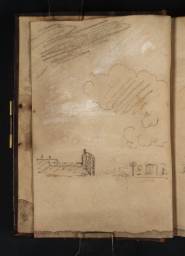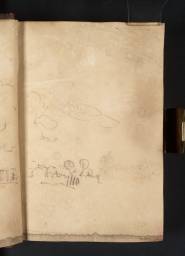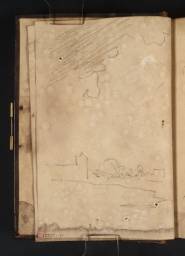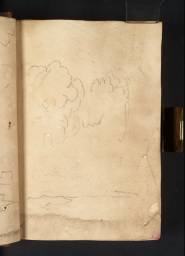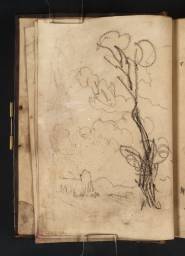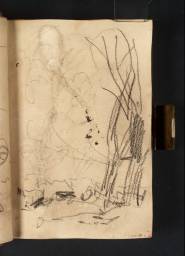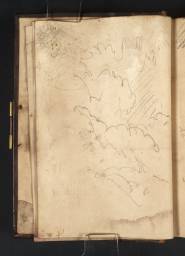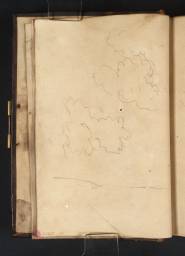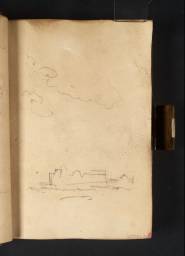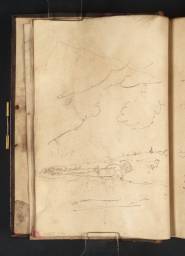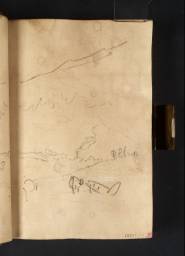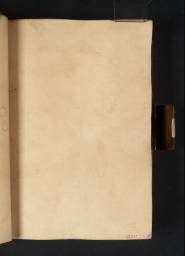Turner Bequest LXXXV
Sketchbook bound in calf, with gold tooled edges and spine and brass clasp
100 leaves, comprising two white wove writing papers, one made on a double-faced mould by William Balston and Finch and Thomas Robert Hollingworth at Turkey Mill, Maidstone, Kent and the other made on a double-faced or perhaps a transitional mould by the same makers or the younger James Whatman also at Turkey Mill, prepared with a slatey brown wash
Approximate page size 166 x 112 mm
Made up by William Dickie. Some leaves of the first paper show parts of the watermark ‘1794 | J WHATMAN’ and of the second ‘J WHATMAN’
Inscribed in ink by an unknown hand ‘LXXXV | No schedule Number recorded’ inside front cover
100 leaves, comprising two white wove writing papers, one made on a double-faced mould by William Balston and Finch and Thomas Robert Hollingworth at Turkey Mill, Maidstone, Kent and the other made on a double-faced or perhaps a transitional mould by the same makers or the younger James Whatman also at Turkey Mill, prepared with a slatey brown wash
Approximate page size 166 x 112 mm
Made up by William Dickie. Some leaves of the first paper show parts of the watermark ‘1794 | J WHATMAN’ and of the second ‘J WHATMAN’
Inscribed in ink by an unknown hand ‘LXXXV | No schedule Number recorded’ inside front cover
Accepted by the nation as part of the Turner Bequest 1856
Exhibition history
References
This sketchbook contains sketches of an eclipse of the sun, most probably in or near London on 11 February 1804.
When exhibited (for the first time) in the 1996 Tate exhibition, the book was given a date range of 1802–4 rather than Finberg’s date of 1804, on the grounds that Turner could have witnessed an eclipse in August 1802 while travelling on the Continent as well as that in 1804 cited by Finberg. However, Finberg’s date was surely correct, based as it was on data from the Royal Observatory at Greenwich showing that a three-quarter eclipse was visible in London on 11 February 1804. This began with first contact in London at 10.36am, reached maximum magnitude at 11.53 and ended at 13.10pm.1 As sketches in the book clearly show the sun eclipsed by three-quarters, this must be the occasion depicted.
Other than a large building which recurs in most of the sketches together with trees, there is no internal evidence in the sketches for where Turner went to draw the eclipse, but open ground in one of the London parks or perhaps the banks of the Thames could have provided good viewpoints. The landscape, such as it is, is usually level rather than hilly, ruling out such locations as Hampstead, Primrose Hill or Greenwich Park. Turner made his sketches in chalks over a prepared ground, working quickly across double-page spreads. He made six sketches, leaving the rest of the book empty. In the first three double-spreads, folios 1 verso–2, 2 verso–3 and 3 verso–4 (D05246–D05247, D05248–D05249, D05250–D05251), the viewpoint is the same, with a row of buildings in the middle distance, perhaps on the riverside, and a taller building on the left; the deepening gloom as the eclipse progresses is seen to reduce the definition of the buildings and bring the clumps of trees in the foreground into darker prominence.
Although the folios were numbered by John Ruskin in red ink, the book was not given a number as part of the Turner schedule or endorsed by Turner’s Executors, who may have thought it too slight to record. It is however an interesting early example of Turner’s interest in natural phenomena, which was to lead to many studies of the sky and its effects. Hamilton describes it as ‘the earliest-known specific observation of an astronomical event by Turner’, noting that the artist was positioned and prepared to record the event. Hamilton also comments on the advance notifications of eclipses in the Nautical Almanac and suggests that Turner made use of sailor’s tables.2
Technical notes
How to cite
David Blayney Brown, ‘Eclipse sketchbook 1804’, sketchbook, November 2004, in David Blayney Brown (ed.), J.M.W. Turner: Sketchbooks, Drawings and Watercolours, Tate Research Publication, March 2023, https://www

